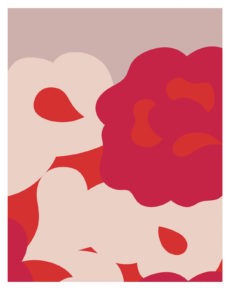With Design Yard Sale, a cohort of five Harvard Graduate School of Design students and recent graduates aims to both raise awareness of social and racial justice in design, and directly support anti-racism organizations.
Officially launched on July 1, Design Yard Sale has operated like a virtual auction and gift shop. Its catalog has included a curated range of original sketches, paintings, furniture, books, and apparel, many of which have been both donated and autographed by their designers—among them, Virgil Abloh, Denise Scott Brown, and Frank Gehry.

Design Yard Sale raised $126,000 through its four weeks of sales, with all proceeds benefiting a pair of non-profit organizations dedicated to anti-racist efforts.
Design Yard Sale’s organizers—Grace Chee (MArch ’21), Tessa Crespo (MDes ’20), Edward Han (MArch ’21), Izzy Kornblatt (MDes ’19), and Yaxuan Liu (MArch ’21)—first began conversing via GSD community emails and listservs in late May. Motivated by ongoing social-justice conversations, and catalyzed by the killing of George Floyd by a white police officer, the team felt driven to rewire design’s agency amid a national reckoning on race and justice, one in which the design fields have been directly implicated.
The Design Yard Sale cohort set up the project with no prior fundraising experience, learning and organizing on the fly. Proceeds of Design Yard Sale will benefit two organizations: nonprofit The Bail Project and New Orleans-based architecture and design justice practice Colloqate Design, each of which is dedicated to fighting systemic racism.
“In the face of such deeply rooted violence and oppression, we questioned what role we could play, and as minority designers and students ourselves, we wanted to contribute to the movement in whatever small way we could,” says Chee. “As Jerome Byron, one of our contributors, put it, Design Yard Sale is about promoting strategies for personal spending and redirecting cash to where it matters most.”

The auction’s final lot, which closed last Saturday, August 1, included a signed X-Rocker stool from Herzog & de Meuron and a print of Simone by Farshid Moussavi. Individual works of particular interest have included a a sketch of Queens Public Library by Craig Dykers; photographs of 1960s Las Vegas by Denise Scott Brown; and a sketch of Beekman Street Housing by Frank Gehry, each framed and signed by their respective designer. Jerome Byron offered a glass-fiber-reinforced concrete stool, infused with pink pigment. Other standout items included a Virgil Abloh™ x IKEA MARKERAD Chair from Abloh’s personal archive, to be illustrated on and signed by Abloh with the purchaser’s name, as well as Perry Kulper prints and Harvard GSD’s Womxn in Design Takeout Tote.
Among other ideas, the concept of offering distinctive design items—including furniture and other consumer goods, but also books, sketches, and other works that evoke design’s pedagogical and conceptual undercurrents—arose as a constructive way to celebrate both design’s tangible fruits, and its potential for social agency.
“It was a call to action with a direct, tangible way to help, and that really appealed,” says Crespo. “We all felt a strong obligation to fight against systemic racism and we wanted to do so in a way that provided immediate assistance to leaders on the front lines of the movement.”
For Design Yard Sale’s five organizers, the month of June was a warp-speed crash course in establishing a non-profit organization. Liu initiated e-mail conversations in May; as the team took shape, Han began establishing and deepening an online presence for the growing effort. A first public call for donations went out on the Design Yard Sale Instagram on June 18.
Before and following this first activation, the team strategized Design Yard Sale’s entire scope, from establishing an e-commerce platform to sourcing design objects—not to mention pricing, marketing, and shipping them—as well as studying the relevant international laws and policies governing commercial transactions.
The group secured fiscal sponsorship from the Architectural League of New York with less than 24 hours to spare before the July 1 launch; they set up a bank account that morning, and by that afternoon were starting to ship orders.
Sourcing the auction’s exquisite, unique wares was a similarly collaborative process, if less manic: organizers both tapped into professional and academic networks in order to solicit donated works, but also were approached by various members of the Harvard GSD community as word spread. Among Harvard GSD faculty efforts, Toshiko Mori and Oana Stănescu provided mentorship to the organizers, as well as connections to other designers; Jerold Kayden and colleagues at Harvard’s Transactional Law Clinic helped guide the team through legal considerations; and a variety of faculty—among them Jennifer Bonner, Sean Canty, Jon Lott, Chris Reed, Jeannette Kuo, Malkit Shoshan, Jenny French, Sara Zewde, and Zeina Koreitem—donated works of their own. A full list of Design Yard Sale contributors is on view at the project’s homepage.
At the project’s roots, foregrounding student work was a cornerstone of the cohort’s organizing vision. First batches of donations included models and drawings from fellow Harvard GSD students, while faculty grew involved as word spread. While early conversations among organizers involved questions of which types and mediums of items to include, the team ultimately chose an open approach, inviting works from a range of designers and at a range of price points, enhancing the auction’s accessibility.
“For us, it has always been really important to have student and young-practitioner work be presented on an equal footing with that of better known designers, because so often student work goes unnoticed,” says Kornblatt. “We know of the high caliber of work that happens at the GSD and other design schools, but so much of it ends up just gathering dust. Design Yard Sale allows students to use what they’ve already created to make a difference.”
In serving anti-racist priorities and missions, the team wanted to support both smaller, grassroots work, and broader efforts tackling systemic, anti-Black racism in the criminal justice system. Amid conversations with social-justice-minded colleagues, as well as a poll among Harvard GSD students, organizations the Bail Project and Colloqate Design emerged.
Beyond the July auctions, Design Yard Sale aims to educate and inspire awareness of social justice and systemic racism, especially within but also beyond design. The organizers are considering the project’s future, whether that involves making it an annual tradition, extending it into the Fall 2020 term, or other avenues toward expansion. And, individually, each is conceptualizing other projects geared toward promoting racial justice and equality within the field; Chee recently began developing an Instagram-based storytelling and archival project to chronicle designers of color and their work.
“While the DYS store is closing today, the fight does not end here,” the project’s website reads. “We hope that we can all continue to take part in the long-term battle against racism, both within the design field and in the wider society. In the face of such deep-rooted, systemic violence and oppression, we should never forget the implications that our everyday choices—be it what we read, where we spend, or who we hire—have on creating a better and more equitable future.”
